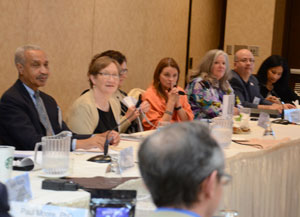Oct 14, 2015
Rural Delivery System Reform Takes Center Stage for National Advisory Committee
by Kate Menzies & Brandon Baumbach

In rural communities, the manner in which healthcare is delivered is often dependent on the financial position of the local healthcare facilities. With limited resources and staff, rural hospitals and clinics are examining the various forms of Delivery System Reform (DSR) they can implement to remain viable in a changing industry. This was a widely discussed topic at the September meeting of the National Advisory Committee on Rural Health and Human Services (NACRHHS) in Mahnomen, Minnesota.
Much of DSR is centered around the Triple Aim, a concept developed by the Institute for Healthcare Improvement. This three-pronged approach is focused on:
- Improving the experience of care for individuals
- Improving the health of populations
- Lowering per capita healthcare costs
Recently, Health and Human Services Secretary Burwell outlined tangible steps to achieving the Triple Aim by tying Medicare payments to quality outcomes or value through alternative payment models, such as Accountable Care Organizations (ACOs) and bundled payment arrangements.
At the NACRHHS meeting, it was recognized that the participation of rural providers in DSR is important, despite challenges and barriers rural communities face.
Rural regions are often at a disadvantage for implementing DSR. Statutory exclusions pose a barrier to DSR, as participation in the Medicare Shared Saving Program requires a certain number of beneficiaries, which inherently excludes low-volume networks of providers. Similarly, quality measures to which payments are tied need to be examined in order to better reflect the nature of care provided in rural locations; otherwise wrongful conclusions may be drawn about the quality of care.
“Measurement is paramount to assuring and demonstrating value,” said Jennifer Lundblad, President and CEO of Stratis Health.
The committee discussed the importance of the recent work of the National Quality Forum Rural Health Committee in highlighting the challenges and potential solutions that would allow rural facilities and practices to engage in quality improvement and pay-for-performance programs.
Workforce shortages, both in terms of number of providers and specialties represented, make it difficult for rural facilities to meet DSR objectives and the quality standards attached to payments.
It's been said that form follows function. In healthcare, function and form follow finance.
Limited financial resources also put rural communities on unequal footing, as system reform requires an investment. With smaller budgets and profit margins, rural facilities often need more assistance during the implementation of these new programs.
“It's been said that form follows function. In healthcare, function and form follow finance,” stated Paul Moore, Senior Advisor at the Federal Office of Rural Health Policy.
With the right incentives and the ability to share patient information, healthcare access and quality could be improved, resulting in better outcomes.
During the NACRHHS meeting, participants acknowledged that much is happening with rural DSR despite the challenges in both the public and private sectors. In the public sector, new payment models (particularly the ACO Investment Model), patient-centered medical homes, State Innovation Model (SIM) programs, community transformation grants, value-based purchasing practices, and workforce initiatives are all underway and attempting to improve rural care. In the private sector, payer-provider contracts for accountable care, patient-centered care teams, and other initiatives have been implemented to increase access to quality care.
From the information gleaned from the speaker presentations and site visits to healthcare facilities in Detroit Lakes and Fergus Falls, Minnesota, the committee will make recommendations to Secretary Burwell to better address the challenges of DSR in rural areas.
The committee's discussion looked at policy solutions that could help rural facilities succeed as DSR moves forward, including:
- Mandatory participation in CMS quality improvement programs through a phased approach
- Further development of rural-relevant quality measures that are tied to reimbursement
- Encouraging voluntary groupings of rural providers for payment incentives
Throughout the meeting, it was reiterated that care delivery redesign is necessary, and that the opportunities are far-reaching. To make these new delivery models successful, however, effective care coordination is essential.
